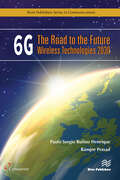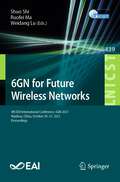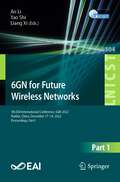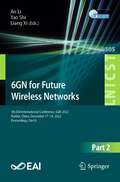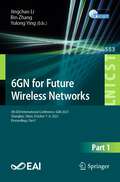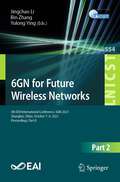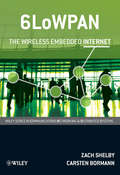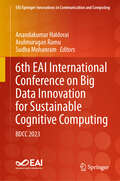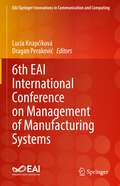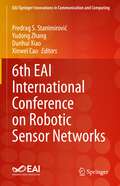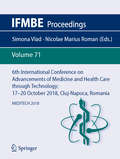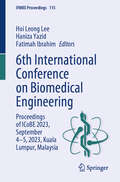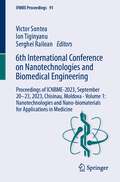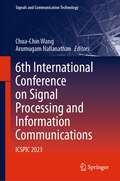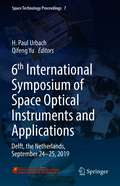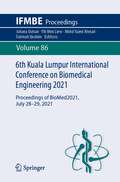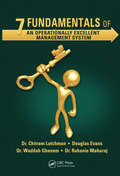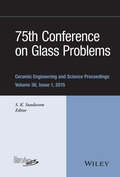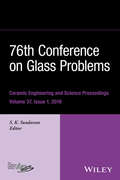- Table View
- List View
6G: The Road To Future Wireless Technologies 2030 (River Publishers Series In Communications Ser.)
by Ramjee Prasad Paulo Sergio HenriqueSince the launch of Second-Generation Networks (2G), planning for each future mobile service was initiated many years before its commercial launch. In 2019, 5G Networks begun to be deployed commercially after almost ten years of planning. Similarly, the race for the 6G wireless networks that will be operational in 2030 has already started. To fulfill its potential in the upcoming decade, 6G will undoubtedly require an architectural orchestration based on the amalgamation of existing solutions and innovative technologies. The book will begin by evaluating the state of the art of all current mobile generations' while looking into their core building blocks. 6G implementation will require fundamental support from Artificial Intelligence (AI) and Machine Learning on the network's edge and core, including a new Radio Frequency (RF) spectrum. The 6G use cases will require advanced techniques for enabling the future wireless network to be human-centric, ensuring enhanced quality of experience (QoE) for most of its applications. The concept of Human Bond Communication Beyond 2050 (Knowledge Home) and Communication, Navigation, Sensing, and Services (CONASENSE) will also profit from future wireless communication. Terahertz domains will exploit the ultra-Massive Multiple Input Multiple Output Antennas (UM-MIMO) technologies to support Terabits' data throughputs.Moreover, optical wireless communications (OWC) will also come into play to support indoor and outdoor high-data rates. Further expansion of 6G core entities will support the novel concept of Society 5.0. Quantum computing processing and communications is also likely to be added into the 6G ecosystem with security managed by blockchain orchestration for a robust network.
6GN for Future Wireless Networks: 4th EAI International Conference, 6GN 2021, Huizhou, China, October 30–31, 2021, Proceedings (Lecture Notes of the Institute for Computer Sciences, Social Informatics and Telecommunications Engineering #439)
by Shuo Shi Ruofei Ma Weidang LuThis book constitutes the proceedings of the 4th International Conference on 6G for Future Wireless Networks, 6GN 2021, held in Huizhou, China, in October 2021. The 63 full papers were selected from 136 submissions and present the state of the art and practical applications of 6G technologies. The papers are arranged thematically in tracks as follows: Advanced Communication and Networking Technologies for 5G/6G Networks; Advanced Signal Processing Technologies for 5G/6G Networks; and Educational Changes in The Age of 5G/6G.
6GN for Future Wireless Networks: 5th EAI International Conference, 6GN 2022, Harbin, China, December 17-18, 2022, Proceedings, Part I (Lecture Notes of the Institute for Computer Sciences, Social Informatics and Telecommunications Engineering #504)
by Ao Li Yao Shi Liang XiThis 2-volume set constitutes the proceedings of the 5th International Conference on 6G for Future Wireless Networks, 6GN 2022, held in Harbin, China, in December 2022. The 60 full papers were selected from 194 submissions and present the state of the art and practical applications of 6G technologies. The papers are arranged thematically in tracks as follows: Resource Allocation for 6G Networks; Security and Privacy for 6G Networks; Big data mining and pattern analysis techniques for 6G Networks; Artificial intelligent techniques for 6G Networks; Mobile Edge Computing for 6G Networks; Unmanned Aerial Vehicle Communication for 6G Networks.
6GN for Future Wireless Networks: 5th EAI International Conference, 6GN 2022, Harbin, China, December 17-18, 2022, Proceedings, Part II (Lecture Notes of the Institute for Computer Sciences, Social Informatics and Telecommunications Engineering #505)
by Ao Li Yao Shi Liang XiThis 2-volume set constitutes the proceedings of the 5th International Conference on 6G for Future Wireless Networks, 6GN 2022, held in Harbin, China, in December 2022.The 60 full papers were selected from 194 submissions and present the state of the art and practical applications of 6G technologies. The papers are arranged thematically in tracks as follows: Resource Allocation for 6G Networks; Security and Privacy for 6G Networks; Big data mining and pattern analysis techniques for 6G Networks; Artificial intelligent techniques for 6G Networks; Mobile Edge Computing for 6G Networks; Unmanned Aerial Vehicle Communication for 6G Networks.
6GN for Future Wireless Networks: 6th EAI International Conference, 6GN 2023, Shanghai, China, October 7-8, 2023, Proceedings, Part I (Lecture Notes of the Institute for Computer Sciences, Social Informatics and Telecommunications Engineering #553)
by Bin Zhang Jingchao Li Yulong YingThis 2-volume set constitutes the proceedings of the 6th EAI International Conference on 6GN for Future Wireless Networks, 6GN 2023, held in Shanghai, China, in October 7-8, 2023. The 60 full papers were selected from 151 submissions and present the state of the art and practical applications of 6G technologies. The papers are arranged thematically in tracks as follows: intelligent systems; big data mining, D2D communication, security and privacy for 6G networks; artificial intelligent techniques for 6G networks; power and energy systems I; power and energy system; power and energy systems; image, video, and signal processing; image, video, and signal processing & software engineering; communications systems and networking & control and automation systems; computer systems and applications.
6GN for Future Wireless Networks: 6th EAI International Conference, 6GN 2023, Shanghai, China, October 7-8, 2023, Proceedings, Part II (Lecture Notes of the Institute for Computer Sciences, Social Informatics and Telecommunications Engineering #554)
by Bin Zhang Jingchao Li Yulong YingThis 2-volume set constitutes the proceedings of the 6th EAI International Conference on 6GN for Future Wireless Networks, 6GN 2023, held in Shanghai, China, in October 7-8, 2023.The 60 full papers were selected from 151 submissions and present the state of the art and practical applications of 6G technologies. The papers are arranged thematically in tracks as follows: intelligent systems; big data mining, D2D communication, security and privacy for 6G networks; artificial intelligent techniques for 6G networks; power and energy systems I; power and energy system; power and energy systems; image, video, and signal processing; image, video, and signal processing & software engineering; communications systems and networking & control and automation systems; computer systems and applications.
6LoWPAN
by Carsten Bormann Zach Shelby"It is stunningly thorough and takes readers meticulously through the design, configuration and operation of IPv6-based, low-power, potentially mobile radio-based networking." Vint Cerf, Vice President and Chief Internet Evangelist, GoogleThis book provides a complete overview of IPv6 over Low Power Wireless Area Network (6LoWPAN) technologyIn this book, the authors provide an overview of the 6LoWPAN family of standards, architecture, and related wireless and Internet technology. Starting with an overview of the IPv6 'Internet of Things', readers are offered an insight into how these technologies fit together into a complete architecture. The 6LoWPAN format and related standards are then covered in detail. In addition, the authors discuss the building and operation of 6LoWPAN networks, including bootstrapping, routing, security, Internet ingration, mobility and application protocols. Furthermore, implementation aspects of 6LoWPAN are covered.Key Features:Demonstrates how the 6LoWPAN standard makes the latest Internet protocols available to even the most minimal embedded devices over low-rate wireless networks Provides an overview of the 6LoWPAN standard, architecture and related wireless and Internet technology, and explains the 6LoWPAN protocol format in detail Details operational topics such as bootstrapping, routing, security, Internet integration, mobility and application protocols Written by expert authors with vast experience in the field (industrial and academic) Includes an accompanying website containing tutorial slides, course material and open-source code with examples (http://6lowpan.net ) 6LoWPAN: The Wireless Embedded Internet is an invaluable reference for professionals working in fields such as telecommunications, control, and embedded systems. Advanced students and teachers in electrical engineering, information technology and computer science will also find this book useful.
6th EAI International Conference on Big Data Innovation for Sustainable Cognitive Computing: BDCC 2023 (EAI/Springer Innovations in Communication and Computing)
by Anandakumar Haldorai Arulmurugan Ramu Sudha MohanramThis book features the proceedings of the 6th EAI International Conference on Big Data Innovation for Sustainable Cognitive Computing (BDCC 2023). The papers feature detail on cognitive computing and its self-learning systems that use data mining, pattern recognition and natural language processing (NLP) to mirror the way the human brain works. This international conference focuses on technologies from knowledge representation techniques and natural language processing algorithms to dynamic learning approaches. Topics covered include Data Science for Cognitive Analysis, Real-Time Ubiquitous Data Science, Platform for Privacy Preserving Data Science, and Internet-Based Cognitive Platform.
6th EAI International Conference on Management of Manufacturing Systems (EAI/Springer Innovations in Communication and Computing)
by Lucia Knapčíková Dragan PerakovićThe book presents the proceedings of the 6th EAI International Conference on Management of Manufacturing Systems (MMS 2021), which took place online on October 6, 2021. The conference covered management of manufacturing systems with support for Industry 4.0, logistics and intelligent manufacturing systems and applications, cooperation management and its effective applications. Topics include RFID applications, economic impacts in logistics, ICT support for Industry 4.0, industrial and smart logistics, intelligent manufacturing systems and applications, and much more.
6th EAI International Conference on Robotic Sensor Networks (EAI/Springer Innovations in Communication and Computing)
by Xinwei Cao Yudong Zhang Predrag S. Stanimirović Dunhui XiaoThis book presents the proceedings of the 6th EAI International Conference on Robotics and Networks 2022 (ROSENET 2022). The conference explores the integration of networks and robotic technologies, which has become a topic of increasing interest for both researchers and developers from academic fields and industries worldwide. The authors posit that big networks will be the main approach to the next generation of robotic research, with the explosive number of networks models and increasing computational power of computers significantly extending the number of potential applications for robotic technologies while also bringing new challenges to the networking community. The conference provided a platform for researchers to share up-to-date scientific achievements in this field. The conference took place at Swansea University, Wales, Great Britain.
6th International Conference on Adhesive Bonding 2021: Selected Contributions of AB 2021 (Proceedings in Engineering Mechanics)
by Robert D. Adams Lucas F. M. da SilvaThis book focusses on structural bonding, including many facets, like fundamental aspects of adhesion, science and technology of surfaces, adhesive materials, mechanical properties of bonded joints, innovative designs and applications, testing and standardization, industrial aspects, quality procedures, environmental and ecological aspects. This first volume of the new series gathers selected contributions of the 6th international conference on structural adhesive bonding AB 2021, held in Porto, Portugal, 8-9 July 2021, represents the latest trends and serves as a reference volume for researchers and graduate students working in this field.
6th International Conference on Advancements of Medicine and Health Care through Technology; 17–20 October 2018, Cluj-Napoca, Romania: MEDITECH 2018 (IFMBE Proceedings #71)
by Simona Vlad Nicolae Marius RomanThis volume presents the contributions of the 6th International Conference on Advancements of Medicine and Health Care through Technology – MediTech 2018, held between 17 – 20 October 2018 in Cluj-Napoca, Romania. The papers of this Proceedings volume present new developments in :- Health Care Technology- Medical Devices, Measurement and Instrumentation- Medical Imaging, Image and Signal Processing- Modeling and Simulation- Molecular Bioengineering- Biomechanics
6th International Conference on Biomedical Engineering: Proceedings of ICoBE 2023, September 4–5, 2023, Kuala Lumpur, Malaysia (IFMBE Proceedings #115)
by Fatimah Ibrahim Hoi Leong Lee Haniza YazidThis book gathers the proceedings of the 6th International Conference on Biomedical Engineering (ICoBE 2023), which was held on September 4-6th, 2023, in a hybrid form, in Kuala Lumpur, Malaysia. The sixty-five peer-reviewed papers included here cover a diverse range of topics such as bioinstrumentation and biomedical devices, biomedical signal and image processing, artificial intelligence, bioinformatics and Internet of Things (IoT) in healthcare, as well as biomaterials, biomechanics and rehabilitation, and report on both theoretical and practical findings, achieved in different countries (including Philippines, Indonesia, Japan, United Arab Emirates, and Italy) besides Malaysia. Addressing an interdisciplinary audience of engineers, physicists, scientists, and researchers, this book offers extensive information on the current role and challenges of computer methodologies, artificial intelligence and machine learning in healthcare, together with strategies to improve healthcare through innovation. It truly reflects the theme of the 6th conference edition namely “Be the Change: The Key to Better Healthcare Quality”.
6th International Conference on Nanotechnologies and Biomedical Engineering: Proceedings of ICNBME-2023, September 20–23, 2023, Chisinau, Moldova - Volume 1: Nanotechnologies and Nano-biomaterials for Applications in Medicine (IFMBE Proceedings #91)
by Ion Tiginyanu Victor Sontea Serghei RaileanThis book reports on advances in fundamental and applied research at the interface between nanotechnology and biomedical engineering. Gathering peer-reviewed contributions to the 6th International Conference on Nanotechnologies and Biomedical Engineering, ICNBME held on September 20-23, 2023, in Chisinau, Republic of Moldova, this first volume of the proceedings focuses on nanotechnologies and nano-biomaterials, and their applications in medicine. With a good balance of theory and practice, the book offers a timely snapshot of multidisciplinary research at the interface between physics, chemistry, biomedicine, materials science, and engineering.
6th International Conference on Nanotechnologies and Biomedical Engineering: Proceedings of ICNBME-2023, September 20–23, 2023, Chisinau, Moldova - Volume 2: Biomedical Engineering and New Technologies for Diagnosis, Treatment, and Rehabilitation (IFMBE Proceedings #92)
by Ion Tiginyanu Victor Sontea Serghei RaileanThis book reports on advances in fundamental and applied research at the interface between nanotechnology and biomedical engineering. Gathering peer-reviewed contributions to the 6th International Conference on Nanotechnologies and Biomedical Engineering, ICNBME held on September 20-23, 2023, in Chisinau, Republic of Moldova, this second volume of the proceedings focuses on clinical engineering and instrumentation, bioinformatics, image and signal processing techniques, and new technologies for medical diagnosis, treatment and personalised medicine. With a good balance of theory and practice, the book offers a timely snapshot of multidisciplinary research at the interface between physics, chemistry, biomedicine, materials science, and engineering.
6th International Conference on Signal Processing and Information Communications: ICSPIC 2023 (Signals and Communication Technology)
by Chua-Chin Wang Arumugam NallanathanThis book presents the proceedings of the 6th International Conference on Signal Processing and Information Communications (ICSPIC 2023), which was held in Singapore, on February 25-27, 2023. The conference aims to provide a leading international forum for researchers, practitioners, and professionals from the industry, academia and government to share their new ideas, progresses and achievements in signal processing and information communications. The contributions focus on the latest advances, trends and future challenges in analog and mixed signal processing, design and implementation of signal processing systems, compressive sensing, machine learning methods for communications and signal processing, multimedia signal processing, natural language processing, next generation mobile communications, nonlinear signal processing, optical communications, parallel and distributed processing, and more.
6th International Symposium of Space Optical Instruments and Applications: Delft, the Netherlands, September 24–25, 2019 (Space Technology Proceedings #7)
by H. Paul Urbach Qifeng YuThis proceedings volume contains selected and expanded contributions presented at the 6th International Symposium of Space Optical Instruments and Applications, held in Delft, the Netherlands on Sep 24th–25th, 2019. The meeting was organized by the Sino-Holland Space Optical Instruments Joint Laboratory and supported by TU Delft.The symposium focused on key innovations of space-based optical instruments and applications, and the newest developments in theory, technology and applications in optics, in both China and Europe. It thus provided a platform for exchanges on the latest research and current and planned optical missions.The major topics covered in these conference proceedings are: space optical remote sensing system design; advanced optical system design and manufacturing; remote sensor calibration and measurement; remote sensing data processing and information retrieval; and remote sensing data applications.
6th International Technical Conference on Advances in Computing, Control and Industrial Engineering (Lecture Notes in Electrical Engineering #920)
by Yuriy S. Shmaliy Abdelhalim Abdelnaby ZekryThis proceedings focus on selected aspects of recent advances and experiences, emerging technology trends that have positively impacted our world from operators, authorities and associations from around the world to help address the world’s computing, control and industrial engineering. Meanwhile, although the group that studies Computing, Control and Industrial Engineering is very large, the topics included into this proceedings have the extremely high research value. The program chair, speakers, and editors of this conference are well-known person in the industry, and CCIE2021 will also strictly select articles when calling for papers.
6th Kuala Lumpur International Conference on Biomedical Engineering 2021: Proceedings of BioMed2021, July 28-29, 2021 (IFMBE Proceedings #86)
by Fatimah Ibrahim Juliana Usman Mohd Yazed Ahmad Yih Miin LiewThis book presents cutting-edge research and developments in the field of biomedical engineering, with a special emphasis on achievements by Asian research groups. It covers machine learning and computational modeling methods applied to biomedical and clinical research, advanced methods for biosignal processing and bioimaging, MEMS applications, and advances in biosensors. Further topics include biomechanics, prosthetics, orthotics and tissue engineering. Other related (bio-) engineering applications, such as in ecosystem development, water quality assessment, and material research, are also covered. Gathering the proceedings of the 6th Kuala Lumpur International Conference on Biomedical Engineering, held online on July 28-29, 2021 from Kuala Lumpur, Malaysia, the book is intended to provide researchers and professionals with extensive and timely information on the state-of-the-art research and applications in biomedical engineering, and to promote interdisciplinary and international collaborations.
7 Fundamentals of an Operationally Excellent Management System
by Douglas Evans Waddah Shihab Ghanem Al Hashemi Chitram Lutchman Rohanie MaharajDeveloping and maintaining a disciplined management system provides any organization with a blueprint for exceptional performance and success. Indeed, for larger multinational corporations, a management system is a critical component for sustainable growth and performance management. In this book, the authors discuss a series of fundamentals for cr
7 Steps to Midnight
by Richard MathesonIn this suspense thriller by the author of I Am Legend and Now You See It, a man is on the run for his life after he&’s replaced by an impostor.Government mathematician Chris Barton lives a routine life—until, at the end of an ordinary workday, he finds his car missing from the employee parking lot. When he finally arrives home, there is a stranger living in his house—a man who claims to be him. Thrust suddenly into a surreal world where the evidence of his senses cannot be trusted and strangers are trying to kill him, Chris must avoid violent assassins while following a trail of cryptic clues to regain his life . . . &“Matheson is the master of paranoia—pitting a single man against unknown horrors and examining his every slow twist in the wind. 7 Steps is a book to be devoured in one long swallow.&” —San Jose Mercury News &“Richard Matheson is one of the great names in American terror fiction. 7 Steps to Midnight commands attention. . . . The writing is fortunately up to Matheson's high standards. This is a novel that flies across the page.&” —The Philadelphia InquirerPraise for Richard Matheson &“The author who influenced me the most as a writer was Richard Matheson.&” —Stephen King&“One of the greatest writers of the twentieth century.&” —Ray Bradbury
70 Years of China’s Bridges
by Wei Xu Zhongfu Xiang Anshuang Liu Fanchao MengThe book takes time as the axis, selecting 98 bridges (or bridge groups) across the country and 7 representative bridges out of the country, reflecting the steps and development of China's bridge construction in related majors and engineering technicians in colleges and universities. This book aims to let the general public understand the arduous history of China's bridge construction and the rapid development of China's bridge construction without the country's economic development, strength, and hard work of the bridge people. It is also hoped that the public will enjoy the convenience of bridges, highways, railroads, and urban roads and at the same time enhance their awareness of bridge knowledge, knowledge, love, and scientific use of bridges. This book is used by the general public to understand the development of China's bridge construction, but also as a reference book for teachers and students of bridge engineering-related majors and engineering technicians in colleges and universities.
75th Anniversary of the Transistor
by Arokia Nathan Samar K. Saha Ravi M. Todi75th Anniversary of the Transistor 75th anniversary commemorative volume reflecting the transistor's development since inception to current state of the art 75th Anniversary of the Transistor is a commemorative anniversary volume to celebrate the invention of the transistor. The anniversary volume was conceived by the IEEE Electron Devices Society (EDS) to provide comprehensive yet compact coverage of the historical perspectives underlying the invention of the transistor and its subsequent evolution into a multitude of integration and manufacturing technologies and applications. The book reflects the transistor's development since inception to the current state of the art that continues to enable scaling to very large-scale integrated circuits of higher functionality and speed. The stages in this evolution covered are in chronological order to reflect historical developments. Narratives and experiences are provided by a select number of venerated industry and academic leaders, and retired veterans, of the semiconductor industry. 75th Anniversary of the Transistor highlights: Historical perspectives of the state-of-the-art pre-solid-state-transistor world (pre-1947) leading to the invention of the transistor Invention of the bipolar junction transistor (BJT) and analytical formulations by Shockley (1948) and their impact on the semiconductor industry Large scale integration, Moore's Law (1965) and transistor scaling (1974), and MOS/LSI, including flash memories — SRAMs, DRAMs (1963), and the Toshiba NAND flash memory (1989) Image sensors (1986), including charge-coupled devices, and related microsensor applications With comprehensive yet succinct and accessible coverage of one of the cornerstones of modern technology, 75th Anniversary of the Transistor is an essential reference for engineers, researchers, and undergraduate students looking for historical perspective from leaders in the field.
75th Conference on Glass Problems
by S. K. SundaramThe 75th Glass Problem Conference is organized according to the following themes: Glass Melting, Forming, Energy and Environmental, Refractories, Sensors and Control, Modeling
76th Conference on Glass Problems, Version A: A Collection of Papers Presented at the 76th Conference on Glass Problems, Greater Columbus Convention Center, Columbus, Ohio, November 2-5, 2015
by S. K. SundaramThe Ceramic Engineering and Science Proceeding has been published by The American Ceramic Society since 1980. This series contains a collection of papers dealing with issues in both traditional ceramics (i.e., glass, whitewares, refractories, and porcelain enamel) and advanced ceramics. Topics covered in the area of advanced ceramic include bioceramics, nanomaterials, composites, solid oxide fuel cells, mechanical properties and structural design, advanced ceramic coatings, ceramic armor, porous ceramics, and more.
